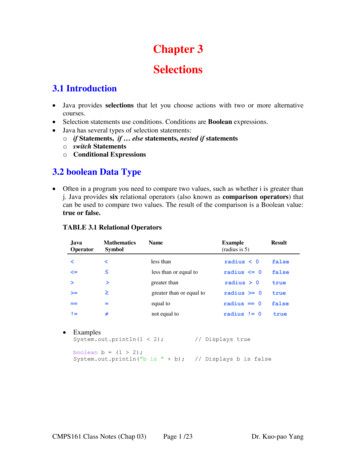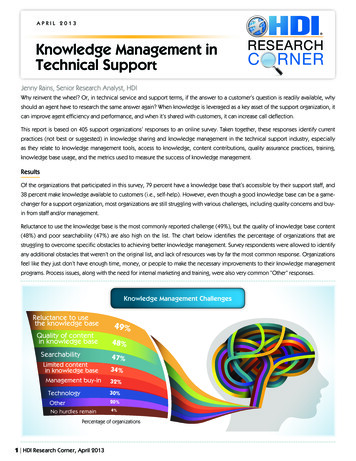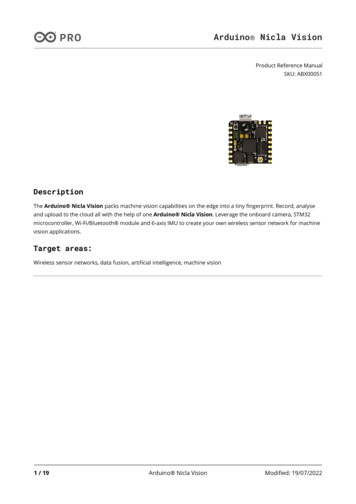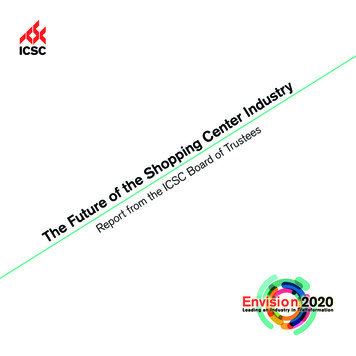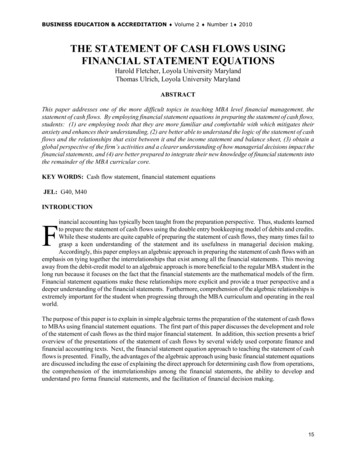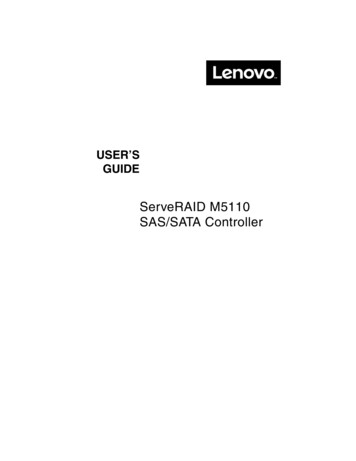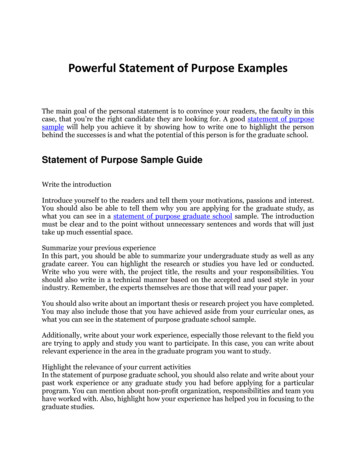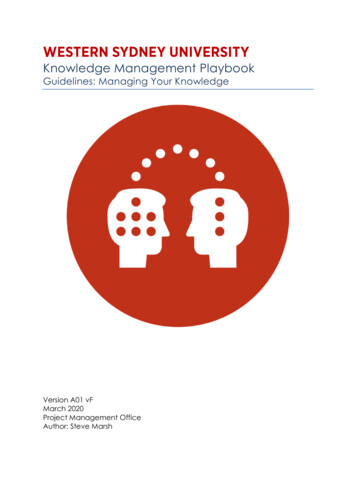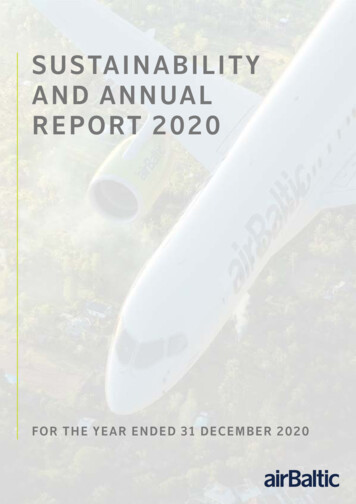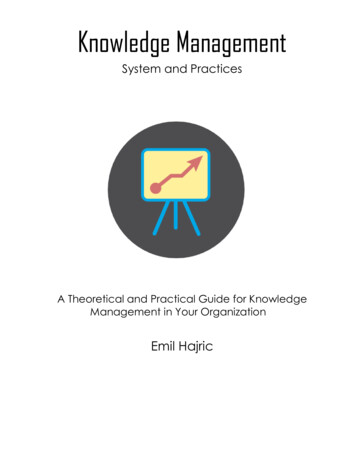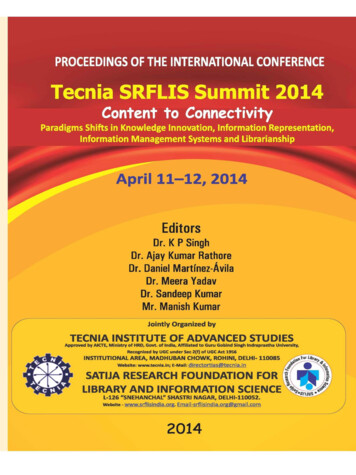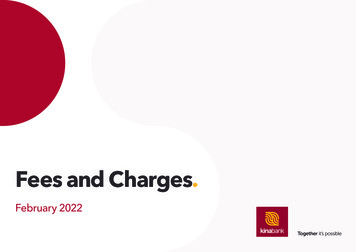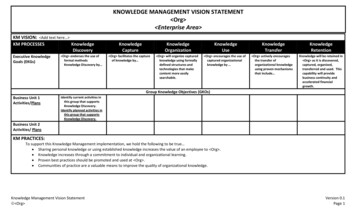
Transcription
KNOWLEDGE MANAGEMENT VISION STATEMENT Org Enterprise Area KM VISION: Add text here KM PROCESSESKnowledgeDiscoveryExecutive KnowledgeGoals (EKGs) Org endorses the use offormal methodsKnowledge Discovery by KnowledgeCapture Org facilitates the captureof knowledge by KnowledgeOrganizationKnowledgeUse Org will organize capturedknowledge using formallydefined structures andtechnologies that makecontent more easilysearchable. Org encourages the use ofcaptured organizationalknowledge by KnowledgeTransfer Org actively encouragesthe transfer oforganizational knowledgeusing proven mechanismsthat include KnowledgeRetentionKnowledge will be retained in Org as it is discovered,captured, organized,transferred and used. Thiscapability will providebusiness continuity andaccelerated financialgrowth.Group Knowledge Objectives (GKOs)Business Unit 1Activities/PlansIdentify current activities inthis group that supportsKnowledge Discovery.Identify planned activities inthis group that supportsKnowledge Discovery.Business Unit 2Activities/ PlansKM PRACTICES:To support this Knowledge Management implementation, we hold the following to be true Sharing personal knowledge or using established knowledge increases the value of an employee to Org . Knowledge increases through a commitment to individual and organizational learning. Proven best practices should be promoted and used at Org . Communities of practice are a valuable means to improve the quality of organizational knowledge.Knowledge Management Vision Statement Org Version 0.1Page 1
KRP General StatementFor Organization Date Created: MM/DD/YYLast Revision: MM/DD/YYKNOWLEDGERETENTION POLICYLevel One StudyVersion 1.0 Date Created for: Organization Confidential information to Organization Page 1
KRP General StatementFor Organization Date Created: MM/DD/YYLast Revision: MM/DD/YYKNOWLEDGE RETENTION POLICYGeneral StatementA Knowledge Retention Policy is formal written document that declares intellectual properties considered to be vital organizationalassets. Similar to a list of physical assets, this document identifies an organization’s intellectual assets. A Knowledge RetentionPolicy defines Knowledge Areas Knowledge Topics Knowledge Transfer MechanismsKNOWLEDGE AREAS are groupings of organizational knowledge that are recognizable to the total enterprise. Knowledge Areasmay be formal organizational units or important functions performed by a subset of the organization. The classification of KnowledgeAreas is arbitrary and serves only to give structure and organization to Knowledge Topics.RESPONSIBLE PARTY represents the person, persons or organizational unit who has the authority over and the organizationalaccountability for this specific Knowledge Area. They will be responsible for validating the Knowledge Topics and other attributes.KNOWLEDGE TOPICS are recognizable collections of repeatable processes and/or data that are significant to the organization.Knowledge Topics may be organizational programs, business processes, business data and application systems. Each KnowledgeTopic should be ranked as to how significant it is to the enterprise along with the status of knowledge transfer.ORG.SIG.VICMEANINGThis knowledge is VITAL to the organization. Failure tocapture and transfer this knowledge will causeoperational failure.This knowledge is IMPORTANT to the organization.Failure to capture and transfer this knowledge willcompromise operations.This knowledge is CONVENIENT to the organization.Failure to capture and transfer this knowledge willreduce operational efficiency.Confidential information to Organization TRANS.STATUSMEANINGWThis knowledge is well defined and accurate.It may be transferred using establishedmechanisms. No further action is needed.Limited definition is available for thisknowledge. Review and refinement is needed.Formal transfer mechanisms are needed.This knowledge is undocumented and noformal transfer process currently exists.LUPage 2
KRP General StatementFor Organization Date Created: MM/DD/YYLast Revision: MM/DD/YYOWNER/SOURCE indicates the person, persons, or organizational unit, process, software product or collection of data that is theauthority on or the basis for this Knowledge Topic. A Knowledge Topic may have more than one Knowledge Owner/Source. Thisresource will be vital in capturing and transferring this collection of organizational intelligence. Provide names when possible.KNOWLEDGE TRANSFER MECHANISMS represent the means used to codify in some form of permanent record or moveorganizational knowledge from one group of practitioners to another. More than one type of Transfer Mechanism may be used for aspecific Knowledge Topic. Distinct Knowledge Transfer Mechanisms include Documentation – One means to capture and transfer organizational knowledge is using physical or electronic documents. Thismay include all data types including text, graphics and video. This knowledge may be stored on any media including paper,video or electronic record. Apprenticeship – Complex, significant knowledge is often transferred using a relationship between an expert and apprenticepractitioner. Apprenticeship implies a dedicated, sustained transfer process. Training – Organizational knowledge is often transferred using an educational process. Training may be comprised of formaleducation and/or specific task training. Mentoring – As a supplement to other forms of knowledge transfer, mentoring provides on-going benefit. Mentoring includesidentifying people who are available to provide advice and assistance to someone performing a new task. Cross-Training – Many organizations enable knowledge transfer by placing less experienced people with task experts in a “jobshadowing” process. Communications – A great deal of organizational knowledge is transferred using formal and informal communications.Formal communications include professional societies, committees, conferences, job-related websites and reference books.Unstructured communications include social networks, social events and chat rooms.ENTERPRISE AREA identifies what will and will not be addressed in this Knowledge Retention Policy. Common scopedescriptions may be the total organization, distinct operational units, internal or external service providers and specific projects.Confidential information to Organization Page 3
KRP General StatementFor Organization Date Created: MM/DD/YYLast Revision: MM/DD/YYA Knowledge Retention Policy may be created in two levels. A Level One study identifies the Knowledge Areas and KnowledgeTopics along with Topic Descriptions, Organizational Significance, Transfer Status, current Owner(s) and specific KnowledgeTransfer Mechanisms that are or should be used to capture and transfer this knowledge.A Level Two study expands on each of the Transfer Mechanisms by clearly defining the characteristics of this method for capturingand transferring knowledge. A Level Two study confirms the accuracy of the Level One information.The intellectual properties represented in this document should be managed as a significant organizational assetof Organization . Great care should be given to create, discover, refine, capture and share this knowledge.AuthorizationNameTitleDateConfidential information to Organization Page 4
KRP Intellectual Assets InventoryFor Organization Date Created: MM/DD/YYLast Revision: MM/DD/YYKNOWLEDGE RETENTION POLICYIntellectual Assets InventoryENTERPRISE AREA: This KRP Intellectual Assets Inventory identifies the organizational knowledge considered vital to theoperation of Organization .TABLE OF CONTENTS KA NAME . 6Organizational Significance Vital / Important / ConvenientTransfer Status Well-Defined / Limited Definition / UndefinedTransfer Mechanisms ss-Training/CommunicationsConfidential information to Organization Page 5
KRP Intellectual Assets InventoryFor Organization Date Created: MM/DD/YYLast Revision: MM/DD/YYKNOWLEDGE RETENTION POLICYIntellectual Assets InventoryKNOWLEDGE AREA:RESPONSIBLE PARTY: KA Name Knowledge Area description Knowledge TopicDescription Resp. Party Org.Sig.Trans.StatusOwner/SourceTransfer Mechanism(Select and copy this table as needed for each Knowledge Area.)Organizational Significance Vital / Important / ConvenientTransfer Status Well-Defined / Limited Definition / UndefinedTransfer Mechanisms ss-Training/CommunicationsConfidential information to Organization Page 6
KRP Knowledge Attributes Organization Date Created: MM/DD/YYLast Revision: MM/DD/YYKNOWLEDGE RETENTION POLICYLevel 2 Knowledge Transfer Mechanisms MetadataKNOWLEDGE AREAKNOWLEDGE TOPIC(Delete or ignore unneeded Knowledge Transfer Mechanism details)Documentation AttributesNo.Record cess d Name - Document the group name for a distinct group of records that transfer this knowledge.Record Type – Identify the type of record for this group. Type include text, graphics, video and audio.Record Location – Where will this group of records be physically located. This includes URLs, software products or filing location.Update Type – Is this record a static or dynamic document?Revision Schedule - How frequently should this set of records be reviewed and updated?Access Rights – How may this set of records be accessed? What registration, if any, is required to gain access?Security - What type of security is needed to protect this record?Retention Term – How long should this set of records be retained?Disposal - How should this record be archived or destroyed?Confidential information to Organization Page 1 of 6
KRP Knowledge Attributes Organization Date Created: MM/DD/YYLast Revision: MM/DD/YYKNOWLEDGE RETENTION POLICYLevel 2 Knowledge Transfer Mechanisms MetadataTraining AttributesNo.Training NameVendor easures1.2.3.4.Training Name – Provide the name of a formal training program (individual course or series) that facilitates this knowledge transfer.Vendor Information - Include information (URLs) that identifies the vendor, course descriptions and registration information.Training Prerequisites – What previous education or experience level should be completed prior to this training?Resulting Certifications - What degrees or certifications are needed to verify this knowledge transfer?Performance Measures - What performance measures should be met to validate this knowledge transfer?Confidential information to Organization Page 2 of 6
KRP Knowledge Attributes Organization Date Created: MM/DD/YYLast Revision: MM/DD/YYKNOWLEDGE RETENTION POLICYLevel 2 Knowledge Transfer Mechanisms MetadataApprenticeship AttributesNo.Attribute1.Apprentice Qualifications - What skills and/oreducation is needed by an apprentice?2.Apprentice Selection - What are the suggestedselection criteria for an apprentice?3.Selection Process - What is the suggested selectionprocess for an apprentice?4.Apprenticeship Term - Recommended length ofapprenticeship.Confidential information to Organization DescriptionPage 3 of 6
KRP Knowledge Attributes Organization Date Created: MM/DD/YYLast Revision: MM/DD/YYKNOWLEDGE RETENTION POLICYLevel 2 Knowledge Transfer Mechanisms MetadataCross-Training AttributesNo.Attribute1.Trainer Qualifications - What are the criteria forthe trainer?2.Trainee Qualifications - What are the criteria forthe trainee?3.Training Frequency - How frequently should thecross-training sessions occur?4.Training Term - How long should each crosstraining session last?Confidential information to Organization DescriptionPage 4 of 6
KRP Knowledge Attributes Organization Date Created: MM/DD/YYLast Revision: MM/DD/YYKNOWLEDGE RETENTION POLICYLevel 2 Knowledge Transfer Mechanisms MetadataMentoring AttributesNo.Attribute1.Mentor Qualifications - What are the criteria for amentor?2.Mentor Commitment - How much total time andincremental time will be required of a mentor?What is the total length of a mentor relationship?3.Mentor Recognition - What types of recognitionor reward are available for mentors.?Confidential information to Organization DescriptionPage 5 of 6
KRP Knowledge Attributes Organization Date Created: MM/DD/YYLast Revision: MM/DD/YYKNOWLEDGE RETENTION POLICYLevel 2 Knowledge Transfer Mechanisms MetadataCommunications AttributesNo.Communication NameCommunicationTypeInformation SourceContactFrequency1.2.3.Communication Name - What type of formal communication process is recommended?Communication Type – Professional organization, Committee, Publication, Website, Social Network Information Source – URL or address to obtain additional information.Communication Contact – Name of person to contact about this communication.Communication Frequency – How often this communication occurs or how often it should be reviewed.Confidential information to Organization Page 6 of 6
Topics along with Topic Descriptions, Organizational Significance, Transfer Status, current Owner(s) and specific Knowledge Transfer Mechanisms that are or should be used to capture and transfer this knowledge. A Level Two study expands on each of the Transfer Mechanisms by clearly defining the characteristics of this method for capturing
